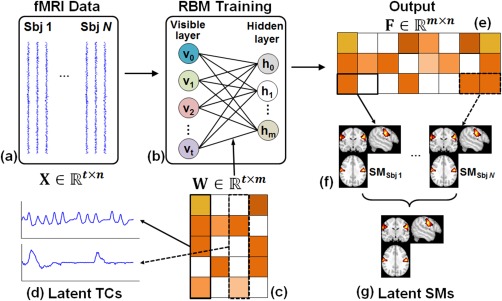Figure 2.

The framework of BSS by applying RBM to the TCs of spatially concatenated fMRI signals of multiple subjects. (a) Spatially concatenated multisubject fMRI data, where N is the number of subjects, t is the number of time points in fMRI sequence, and n is the number of voxels in one subject. (b) RBM training. The number of visible units is t and the number of hidden units is m which specifies the number of latent components. (c) Optimized parameter W. Each column in W is the TC of a latent component (d). (e) The output of RBM model F, representing the parametric representation of inputs based on W. Each row in F represents spatially concatenated SMs of multi‐subjects (f). (g) Groupwise SMs can be derived by group statistical analysis [Color figure can be viewed at http://wileyonlinelibrary.com]
